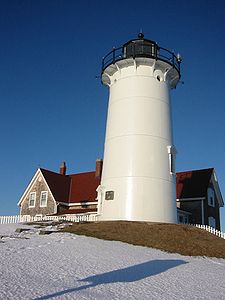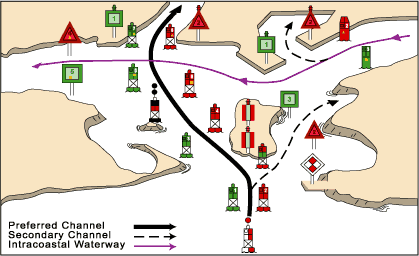
Navigational aid
Encyclopedia

Lighthouse
A lighthouse is a tower, building, or other type of structure designed to emit light from a system of lamps and lenses or, in older times, from a fire, and used as an aid to navigation for maritime pilots at sea or on inland waterways....
s, buoy
Buoy
A buoy is a floating device that can have many different purposes. It can be anchored or allowed to drift. The word, of Old French or Middle Dutch origin, is now most commonly in UK English, although some orthoepists have traditionally prescribed the pronunciation...
s, fog signals, and day beacon
Day beacon
A day beacon is an unlighted nautical sea mark. Typically, day beacons mark channels whose key points are marked by lighted buoys. Day beacons may also mark smaller navigable routes in their entirety. They are the most common aid to nautical navigation in shallow water as they are relatively...
s.
According to the glossary of terms in the United States Coast Guard Light list
Light List
The United States Coast Guard Light List is an American navigation publication in 7 volumes made available yearly by the U.S. Coast Guard which gives information on lighted navigation aids, unlighted buoys, radiobeacons, radio direction finder calibration stations, daybeacons, racons, and LORAN...
, an Aid to Navigation is any device external to a vessel or aircraft specifically intended to assist navigators in determining their position or safe course, or to warn them of dangers or obstructions to navigation.
Lateral markers
Red ATONs always have even numbers, and green ATONs have odd numbers. Under the IALA BInternational Association of Lighthouse Authorities
The International Association of Marine Aids to Navigation and Lighthouse Authorities is a non-profit organization founded in 1957 to collect and provide nautical expertise and advice.-Background:...
standard used in North and South America, when you are going to sea, the red ATON is on your left, and the green on your right. Under the IALA A
International Association of Lighthouse Authorities
The International Association of Marine Aids to Navigation and Lighthouse Authorities is a non-profit organization founded in 1957 to collect and provide nautical expertise and advice.-Background:...
standard used in Europe, Africa and most of Asia, the colors are reversed.
In the IALA B system, the red ATONs are on your right when you return from sea (Red Right Returning) and the green on your left. Red daybeacons are triangles and green daybeacons are squares. All of these ATONs are Lateral Markers that mark traffic channels and where it is safe to travel.
Non-lateral markers

On non-lateral markers, there are some shapes that show certain things:
- Squares - show information, including places to find food, supplies, and repairs. They sometimes show directions.
- Diamonds - warn about dangers like rocks, construction, dams, or stumps.
- Circles - mark a controlled area such as no wake, idles speed, speed limit, or ski zone.
- Crossed diamonds - show areas off limits to all boats, like swimming areas and dams.
Junction buoys
There are some special colored ATONs. When there are red and green horizontal stripes, you are at the junction of two channels. The ATONs indicate the primary channel. If the green is on the top, the preferred channel is to the right. If the red is on top, the preferred channel is to the left. The light matches the top stripe color. These ATONs are sometimes called "junction buoys."AIS ATONs
ATONs are often integrated with AISAutomatic Identification System
The Automatic Identification System is an automatic tracking system used on ships and by Vessel traffic services for identifying and locating vessels by electronically exchanging data with other nearby ships and AIS Base stations...
, e.g. a lighthouse can be equipped with an AIS transitter. Sometimes it is impractical to equip the ATON with an AIS transponder; in this case an AIS shore station can be assigned to transmit AIS messages on behalf of the ATON. This is known as a synthetic ATON.
In other cases, such as marking a wreck until a physical buoy can be deployed, a so-called virtual ATON is created: A shore-based AIS system is configured to transmit AIS messages indicating the existence of an ATON at a specified location.
Lead marks and lights
Lead marks (as in "leading a ship into a safe place") and lights are fixed markers that are laterally displaced to allow a mariner to navigate a fixed channel along the preferred route. They are also known as "channel markers." They can normally be used coming into and out of the channel. When lit, they are also usable at night. Customarily, the upper mark is up-hill from the lower (forward) mark. The mariner will know the geometry of the marks/lights from the navigational chart and can understand that when "open" (not one above the other) the ship needs to be navigated to "close" the marks (so one is above the other) and be in the preferred line of the channel.In some cases, the lead marks/lights are provided by lasers, as in the laser channel under the Tasman Bridge
Tasman Bridge
The Tasman Bridge is a five-lane bridge crossing the Derwent River, near the CBD of Hobart, Tasmania. The bridge has a total length of 1,395 metres . It provides the main traffic route from the CBD to the eastern shore - particularly Hobart International Airport and Bellerive Oval...
on the Derwent River
Derwent River
-Rivers:* Derwent River which flows through Hobart.It may also refer to:* Derwent River which crosses the Birdsville Track at Mungeranie in the Lake Eyre Basin-See also:...
at Hobart, Tasmania
Tasmania
Tasmania is an Australian island and state. It is south of the continent, separated by Bass Strait. The state includes the island of Tasmania—the 26th largest island in the world—and the surrounding islands. The state has a population of 507,626 , of whom almost half reside in the greater Hobart...
.
Further reading
- United States Coast Guard. Aids to Navigation, (Washington, DC: U. S. Government Printing Office, 1945).
- UK Department for Transport. UK Government Strategy for AIS.
- IALA. IALA Standard A-126: On the Use of the Automatic Identification System (AIS) in Marine Aids to Navigation Service.
See also
- USCG aids to navigation boatUSCG aids to navigation boatThe United States Coast Guard maintains roughly 145 Aids to Navigation Boats. These boats were designed primarily to serve within the inland waters of the United States. These vessels include TANB/BUSL/ANB/ANB ranging from 26 to 55 feet in length....
- BuoyBuoyA buoy is a floating device that can have many different purposes. It can be anchored or allowed to drift. The word, of Old French or Middle Dutch origin, is now most commonly in UK English, although some orthoepists have traditionally prescribed the pronunciation...
- DaymarkDaymarkA daymark or a day marker is a structure such as a tower constructed on land as an aid to navigation by sailors. While similar in concept to a lighthouse, a daymark does not have a light and so is usually only visible during daylight hours...
- Distance Measuring EquipmentDistance Measuring EquipmentDistance measuring equipment is a transponder-based radio navigation technology that measures distance by timing the propagation delay of VHF or UHF radio signals....
(DME) - FoghornFoghornA foghorn or fog signal or fog bell is a device that uses sound to warn vehicles of hazards or boats of the presence of other vehicles in foggy conditions. The term is most often used in relation to marine transport...
- Global Positioning SystemGlobal Positioning SystemThe Global Positioning System is a space-based global navigation satellite system that provides location and time information in all weather, anywhere on or near the Earth, where there is an unobstructed line of sight to four or more GPS satellites...
(GPS) - Instrument Landing SystemInstrument Landing SystemAn instrument landing system is a ground-based instrument approach system that provides precision guidance to an aircraft approaching and landing on a runway, using a combination of radio signals and, in many cases, high-intensity lighting arrays to enable a safe landing during instrument...
(ILS) - landmarkLandmarkThis is a list of landmarks around the world.Landmarks may be split into two categories - natural phenomena and man-made features, like buildings, bridges, statues, public squares and so forth...
- LighthouseLighthouseA lighthouse is a tower, building, or other type of structure designed to emit light from a system of lamps and lenses or, in older times, from a fire, and used as an aid to navigation for maritime pilots at sea or on inland waterways....
- LORANLORANLORAN is a terrestrial radio navigation system using low frequency radio transmitters in multiple deployment to determine the location and speed of the receiver....
- Non-Directional BeaconNon-directional beaconA non-directional beacon is a radio transmitter at a known location, used as an aviation or marine navigational aid. As the name implies, the signal transmitted does not include inherent directional information, in contrast to other navigational aids such as low frequency radio range, VHF...
(NDB) - RaconRaconA racon is a radar transponder commonly used to mark maritime navigational hazards. The word is a portmanteau of RAdar and beaCON.When a racon receives a radar pulse, it responds with a signal on the same frequency which puts an image on the radar display...
- Radio navigationRadio navigationRadio navigation or radionavigation is the application of radio frequencies to determine a position on the Earth. Like radiolocation, it is a type of radiodetermination.The basic principles are measurements from/to electric beacons, especially...
- Range light
- Sea markSea markA sea mark, also seamark and navigation mark, is a form of aid to navigation and pilotage aid which identifies the approximate position of a maritime channel, hazard and administrative area to allow boats, ships and seaplanes to navigate safely....
- Tactical Air NavigationTactical Air NavigationA tactical air navigation system, commonly referred to by the acronym TACAN, is a navigation system used by military aircraft. It provides the user with bearing and distance to a ground or ship-borne station. It is a more accurate version of the VOR/DME system that provides bearing and range...
(TACAN) - VHF Omni-directional RangeVHF omnidirectional rangeVOR, short for VHF omnidirectional radio range, is a type of radio navigation system for aircraft. A VOR ground station broadcasts a VHF radio composite signal including the station's identifier, voice , and navigation signal. The identifier is typically a two- or three-letter string in Morse code...
(VOR) - International Regulations for Preventing Collisions at SeaInternational Regulations for Preventing Collisions at SeaThe International Regulations for Preventing Collisions at Sea 1972 are published by the International Maritime Organization , and set out, inter alia, the "rules of the road" or navigation rules to be followed by ships and other vessels at sea in order to prevent collisions between two or more...

